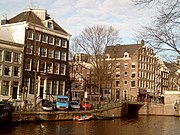
The Prinsengracht is a 3.2-kilometer (2.0 mi)-long canal that runs parallel to the Keizersgracht in the center of Amsterdam. The canal, named after the Prince of Orange, is the fourth of the four main canals belonging to the canal belt.
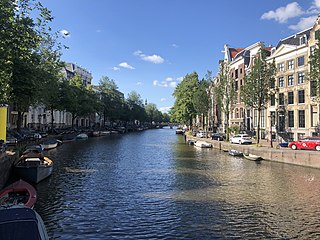
The Keizersgracht is a canal in Amsterdam, the Netherlands. It is the second of the three main Amsterdam canals that together form the Grachtengordel, or canal belt, and lies between the inner Herengracht and outer Prinsengracht.
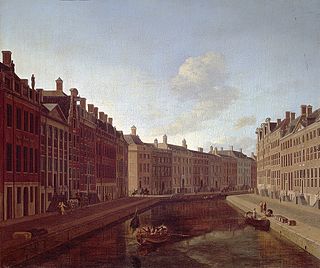
The Herengracht is the second of four Amsterdam canals belonging to the canal belt and lies between the Singel and the Keizersgracht. The Gouden Bocht in particular is known for its large and beautiful canal houses.

Amsterdam, capital of the Netherlands, has more than 100 kilometers (62 mi) of grachten (canals), about 90 islands and 1,500 bridges. The three main canals, dug in the 17th century during the Dutch Golden Age, form concentric belts around the city, known as the Grachtengordel. Alongside the main canals are 1550 monumental buildings. The 17th-century canal ring area, including the Prinsengracht, Keizersgracht, Herengracht and Jordaan, were listed as UNESCO World Heritage Site in 2010, contributing to Amsterdam's fame as the "Venice of the North".

The Grachtengordel is a neighborhood in Amsterdam, Netherlands located in the Centrum district. The seventeenth-century canals of Amsterdam, located in the center of Amsterdam, were added to the UNESCO World Heritage List in August 2010. The Amsterdam Canal District consists of the area around the city's four main canals: the Singel, the Herengracht, the Keizersgracht, and the Prinsengracht. From the Brouwersgracht, the canals are generally parallel with one another, leading gradually southeast into the Amstel river.

De Negen Straatjes is a neighbourhood of Amsterdam, Netherlands located in the Grachtengordel, a UNESCO World Heritage Site.

The Singelgracht is the waterway that borders the entire Amsterdam Center and flows along the Nassaukade, Stadhouderskade and Mauritskade streets. Formerly the canal and the ramparts on the city side formed the outer defenses of the city.

Lijnbaansgracht is a partly filled-in canal in Amsterdam which bends beyond the boundary of the center, Amsterdam-Centrum. The canal runs parallel to the Singelgracht, between the Brouwersgracht and the Reguliersgracht.
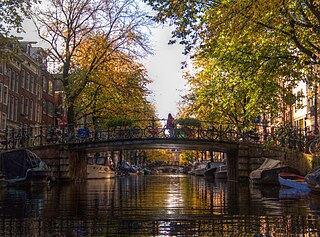
The Egelantiersgracht in Amsterdam is a canal in the Jordaan neighbourhood in the Amsterdam-Centrum borough. The canal lies between the Prinsengracht and the Lijnbaansgracht.

The Passeerdersgracht is a short canal in Amsterdam, the Netherlands, that connects the Prinsengracht with the Lijnbaansgracht. The canal is the southernmost in the Jordaan neighbourhood and borders the west part of the Grachtengordel.

The Bloemgracht is a canal in the Jordaan district of Amsterdam, the Netherlands. It connects the Prinsengracht with the Lijnbaansgracht and runs between and parallel to Nieuwe Leliestraat and Bloemstraat in the Amsterdam-Centrum district. The canal is named after the bulwark "de Bloem", later called "Rijkeroord". From 1614 a windmill was located here, but it was moved to Haarlemmerweg in 1878.
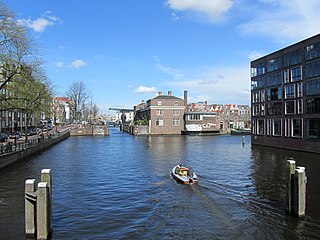
The Nieuwe Herengracht is a canal in Centrum district of Amsterdam. The canal is an extension of the Herengracht that runs between the Amstel and the Scharrebiersluis (lock) leading to the Schippersgracht from the Entrepotdok. It is in the Plantage neighborhood in the eastern part of the Grachtengordel.

The Nieuwe Keizersgracht is a canal in Amsterdam, part of the eastern Grachtengordel.
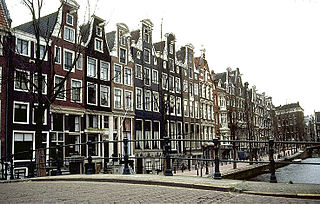
The Leidsegracht is a canal in Amsterdam, the Netherlands. It is a cross-canal in Amsterdam-Center that connects Herengracht, Keizersgracht, Prinsengracht and Lijnbaansgracht and flows into the Singelgracht at Marnixstraat.

The Blauwburgwal is a canal in Amsterdam between the Singel and the Herengracht. It is the shortest canal in the city center and part of the west Grachtengordel.

The Looiersgracht is a short canal in Amsterdam, between Prinsengracht and Lijnbaansgracht in the Jordaan neighborhood of the Amsterdam-Centrum district. The Looiersgracht borders the Grachtengordel. The Oude Looiersstraat runs parallel to the canal, and the Eerste, Tweede and Derde Looiersdwarsstraat are side streets entering the north side.

The Leliegracht is a canal in Amsterdam, the Netherlands, between Herengracht and Prinsengracht. The canal lies within the western Grachtengordel in the Jordaan neighborhood of the Amsterdam-Centrum district.

The Elandsgracht is a street and former canal in Amsterdam, the Netherlands. It runs between the Prinsengracht and the Singelgracht in the Jordaan neighborhood of the Amsterdam-Centrum district. Bridge 169 over the Singelgracht and Bridge 107 over the Lijnbaansgracht connect the Elandsgracht in the direction of the Kinkerstraat. The Elandsgracht is in the west of the Grachtengordel. The Elandsstraat runs parallel to the Elandsgracht. There are houses, shops, cafés and restaurants on the former canal, with parking spaces in the middle.

The Vijzelgracht is a street and former canal in Amsterdam. The Vijzelgracht is adjacent to the Grachtengordel and is an extension of one of the most important city radii for public transport and normal traffic. This through route leads via Vijzelstraat, Rokin, Dam Square and Damrak to Central Station. To the south of Vijzelgracht, the Nieuwe Vijzelstraat connects to Weteringschans.

The Goudsbloemgracht was a street and former canal in Amsterdam, in the Jordaan neighborhood of the Centrum district. After the canal was backfilled in 1857 the street was renamed Willemsstraat.



